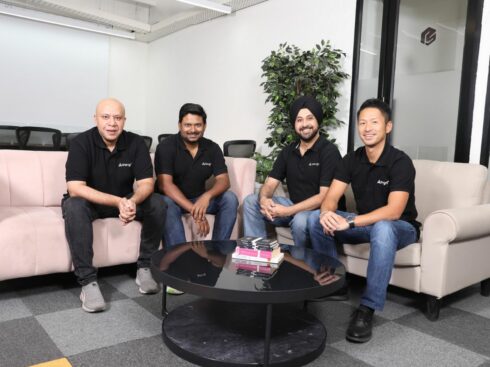
SUMMARY
Lesson 1: Understand your unit economics. Swiggy focussed solely on the consumer; but it wasn’t always a good thing
Learning 2: Beware scaling prematurely. The team learned the hard way that what worked for a specific area may not work at a scale
Learning 3: Not all of Swiggy’s endeavours saw success; Swiggy Stores and Swiggy Daily did not get the traction that the founders intended
When anyone thinks of ordering food, Swiggy is quick to roll off the tongue; the app is synonymous with hungry bachelors, overwrought office-goers, ravenous college students and passionate foodies. A brief foray into the startup’s inception, ideology and operation, reaffirms its status as a food delivery juggernaut.
Just two years shy of a decade-long presence in the foodtech space, the company has seen remarkable scale and frequent reinvention since its establishment in 2014.
The question is: how did they manage that?
The second masterclass of Accel Seed To Scale’s #DecodingMarketplaces, I was joined by the cofounders of Swiggy — Nandan Reddy and Phani Kishan Addepalli — to explore their on-field learnings about scaling, the importance of consumer test beds and falling in love with problems over solutions.
Here are my learnings from the conversation.
Swiggy: All The Right Ingredients
Swiggy spawned from the ruins of another tanked venture with past mistakes as the stepping stones. Reddy and Sriharsha Majety joined forces with Rahul Jamini in Bengaluru to build the app from seed. And it all started with photographs.
“We were roaming around with cameras in Koramangala, clicking photos of food in restaurants,” recalls Nandan.
The hopefuls did what they needed to spread the word; they took a DIY route and created content for the potential restaurant listings on their app, looking up to successful ventures like Flipkart for inspiration.
The Beginning
Bundl was the short-lived predecessor of Swiggy; the ecommerce and courier aggregator was halted due to limited market size. A pivot followed, and the bullseye of the potential aggregator was hit with the restaurant space. One of their first testbeds was Koramangala, an upmarket Bengaluru locale sprawling with eateries.
A Keen Eye For Opportunity
“There were a lot of startups in that [foodtech], more than 10. But no one was really taking on the consumer lens. While you could order a cab and get it within a few minutes, or order on Flipkart and get [the order] delivered very soon, there was no such solution here,” added Nandan Reddy, cofounder of Swiggy.
Patrons struggled with food delivery, which was often patchy, slow and unreliable, if not non-existent. And that is where Swiggy came in.
Curiosity
On the subject of their core ideology, Nandan stresses on placing customer experience above growth, and curiosity above opportunism.
“You should be incredibly curious about the space that you’re going after and not necessarily only be opportunistic,” he said, “because if you are, you can probably end up not being curious after one, two, or three years.”
The lack of curiosity often diminishes the drive to instil a solution mindset, which was successfully dodged in Swiggy’s case.

Breakfast In (Test)bed – All About The Consumer
A testbed is a platform for conducting rigorous market research; as the playbook’s gospel goes, testbeds have to be built around supply
“The one moment when we realised Koramangala was the place where we wanted to start was when we went on that road, which has all the restaurants,” Nandan said “At some level, we realised that supply begets demand, begets supply. And that’s the core of marketplaces as well.”
With that, the team put themselves where the supply was.
The results led to reevaluating the core hypothesis itself; the assumptions around availability and customer experience were challenged, which helped in simplifying the trajectory. “It’s important to reduce as much complexity as possible during the zero-to-one phase, because life in general is also very complex,” Nandan added, “Just peeling off all the layers and figuring out what your core is and then focussing on that core and making sure that all your attention bandwidth is on that particular problem statement is the most important thing.”
The team limited themselves to onboarding just 25 restaurants in the initial phase, so as to not break operations. In a true entrepreneurial fashion, data was combined with gut. Phani, who joined the team soon after inception, emphasised on the “consumer is king” ideology, saying, “First and foremost thing is – do consumers love you? Who are you building for and do they love you?”
“The market is itself large, but if you’re not solving a core problem for a small set of people, then it doesn’t really work,” he added.
Not Biting Off More Than You Can Chew — Keeping Complexity Low
Every Failure Accounts For A New Guideline
Failures often help steer the business into the right direction as it grows past the pitfalls. The testbeds came with their share of wisdom, the most essential being the importance of scaling down before you scale up: the restaurants were limited, the number of menu items were kept low, and the areas were restricted.
In an age of hyper-competition and saturated markets, this might seem like a bold decision; but it successfully curbed data blindness and reduced what Nandan deftly termed as the “blast radius”.
Don’t (Dis)count Your Eggs Before They Hatch
Fledgling companies are prone to handing out frequent discounts to stay afloat, often to the point of loss; but Swiggy steered clear.
“For a really long time, we had this philosophy: the only time we would give a discount to a customer is on the first order,” shared Phani, “Consumers may have a little bit of scepticism to try our service out, so let’s reduce the barrier for them to try. But once they try it, it is the service that actually gets them to come back, not anything else.”
Focus On Experience Over Development
The team took the call to delegate Swiggy’s consumer app to a third party as opposed to building it in-house, thus shifting focus on experience over development. “We had the website, which we developed, but the consumer app itself was outsourced because the majority of our effort was in delivering the right experience,” Phani revealed. The results were forgiving — the app retained nearly 40-45% of its users as opposed to the market average of 20-25%.
A Study In Scaling
As the market was saturated, many obstacles arose — the startup space seemed to be a graveyard of food tech apps. As the team inched for motivation to back Swiggy, they held onto their love for problems and the drive to solve them.
“You need to have a supply and if you don’t have a supply, then when the customers come, you have a poor experience and if the customers don’t come, then the supply’s not there,” said Phani.
Case 1: Putting Customer Experience First, At Any Cost
The orders went from a hundred a day to a thousand, and there came a time when the delivery system was overwhelmed, even broken. This was due to zip dialling, their then mode of delivery operation – an outdated mode full of glitches and errors. The team had to take the decision to shut down the app for 2 days.
“We are not in the business of growing at any cost; we are in the business of serving our customers, and if we don’t serve our customers, we don’t have a business to be built,” he explained, “so we actually shut the business down for a couple of days. Then we were already on track to develop the executive app, and all the senior leadership actually went down to different hubs and onboarded every partner onto the new app, and taught them. Only then did we actually start the service again.”
This proved to be a major step in Swiggy’s operation overhaul and overall upgrade.
Case 2: Decentralise While Scaling
As the company soared, it scaled to other cities. In 2015, the app was launched across major metropolitans across the country, albeit limited to prime areas. The team expanded their workforce and hired extensively across the areas, thus decentralising their operations.
“That’s another important point as you’re scaling up because that is when you get pulled in different directions. You lose leverage for yourself, and you’re not necessarily planning for the future as much as solving for a fire every day,” Nandan said.
Order Your Cake And Eat It Too — Keys To Success
Swiggy saw spontaneous, handsfree growth when its successes stacked on each other and gained momentum, in a phenomenon known as the “flywheel effect”. This begged the question — how?
While no measure can guarantee success for a startup, there are ways to offset common problems and gear towards growth; Swiggy’s playbook has a few measures of its own.
“Can we deliver faster? Can we give it cheaper? Can we give it from the best distance? And there’ll always be work to be done, right?” added Nandan.
Takeaway 1: Get The Basics Right
The foundational lessons remained paramount — namely selection of products, setting appropriate prices, focussing on the convenience of the users.
Takeaway 2: Revisit The Original Testbed
Another route was to go back to the original testbeds whenever a new product or a feature was to be launched. The initial consumer pool enables retention and a stable frequency, thus cancelling out variables.
“A more entrenched customer base means they’re happy to try out other services,” Nandan explained.
Takeaway 3: Understanding Commoditisation
“I think of how commoditised is the underlying product that you find. If the product is really leading, you don’t need to complicate it by adding the vagaries of a marketplace, because the moment it’s a marketplace, you have to deal with a lot more people,” said Phani.
Takeaway 4: Solutions First, Margins Later.
Margins are another factor that form the building blocks of a growing business. The management model of business is ideal for thin margins, while the marketplace model calls for a facilitator between the buyer and seller — namely a middleman — which might erode the margin.
“The first fundamental thing is what is a consumer problem they’re trying to solve for and what is the simplest way in which you solve it? And then of course you layer it with margins and economics,” added Phani=
Good Eggs And Bad Eggs — The Mistakes
Throughout the process, decisions were taken, and mistakes were made. But heads were held high, as errors paved the way for growth.
Learning 1: The Importance Of Figuring Economics
Swiggy unequivocally focussed on the consumer; but it wasn’t always a good thing. At times, the economics were out of order, which required roll-backs and rescinded initiatives.
“I think that’s the biggest learning we have now. There is some sort of a stage gate that we try to see — how much capital is allocated to a business and when the next stage gate VC process within Swiggy [is incorporated]” said Phani.
Learning 2: On Premature Scaling
Premature scaling was another setback. The team learned the hard way that what worked for a specific area may not work at a scale.
Learning 3: Too Many Cooks Spoil The Broth
“There have been times where we add a lot of people in general resources, bandwidth, and you spend a lot even in the zero-to-one stage,” Nandan stated, “And that also pushes out your proof point because you’ve added a lot of complexity suddenly when things are supposed to be very simple.”
Thus, the business needs the least number of people possible to hit the market, so as to maintain flexibility in launching new features or products.
Learning 4: Never Forget The Roots
While Swiggy’s fundamentals were so repeatedly emphasised, the focus wavered at times, especially during marked growth. With more going on, it’s hardly a surprise that one’s attention may be drawn to bigger things as opposed to the basics.
Learning 5: On Unsuccessful Initiatives
Not all of Swiggy’s endeavours saw success; Swiggy Stores and Swiggy Daily did not get the traction that the founders intended.
“We’d launched [Swiggy Stores] across a couple of cities with multiple categories, and then we realised that the customer experience wasn’t completely coming in the way that we wanted, both from an availability and assortment point of view,” Nandan admitted, “So we decided not to scale.”
Swiggy Daily, a subscription-based meal service that tapped into the home chef and health market, sank without a trace. Turns out, the same hungry customers who await and enjoy their food parcels with relish can be quite commitment-phobic towards daily food delivery plans. “If you see food coming every day, you end up having some issue or the other with it and you then decide to churn out,” Nandan added.
Repeat Order? The Swiggy Summary
To sum up Swiggy’s journey, a new product has to focus on their consumers while steadily cutting down complexity.
Since the startup was hyperlocal, the testbed was easy to decipher. The small sample size also helped arrest bad practices and curb them in zero-to-one stages.
While the scaling was fast and unsteady at times, the company’s strong core team handled the operations in every area with much dexterity.
Evidently, Swiggy’s principles from the playbook stood strong throughout their journey. In the world of dime-a-dozen foodtech startups, the app stands out as having maximum public trust and satisfaction, thus placing it in the highest rungs of the industry. The consumers remained kings, well-fed ones at that.


























